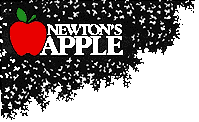
 Show #901
Show #901
 Show #901
Show #901
How can biomechanics help an athlete?
Scientists have developed many devices to analyze every detail of an athletes performance. Advanced sports technology employs high-speed cinematography, force and torque measurement equipment, ergometers, electromyography, wind tunnels, mathematical modeling and many other devices. Athletes also employ biomechanics in their training. Biomechanics is the study of how the laws of physics can be applied to the human body.
The biomechanics of swimming were ignored for years because it was very hard to quantify results in a open pool. But with the flume, a kind of treadmill for swimmers, scientists can now bring high-tech measurement and analysis to the Olympic swimmer.
To understand how the flume helps the swimmer improve the streamlining of a stroke, involves a basic understanding of hydrodynamics. Swimming differs from land sports in that energy must be expended to overcome drag forces which oppose forward movement of an object through a fluid.
The swimmer pushes down into the water with the hand. The water resists this motion, and this force, called drag, is transmitted through the swimmers arm to propel the swimmer through the water. If the swimmer curves the hand and arm, an additional force comes into play: lift. The flow of water over the hand creates the same kind of lift force generated when air flows over an airplane wing. The goal of a winning swimmer is to maximize both the drag and the lift forces. This can be achieved with the assistance of the scientific measurements and analysis made possible by the flume.
Even non-Olympic exercisers now have access to much new technology: weekend joggers or bikers can have a videotape of their performance analyzed for biomechanical advice. Fitness clubs have stationary exercise equipment that offers instant feedback on current and average speeds, distance traveled and calories expended.
Things to Talk About
1. Why would athletes want to see videos of how they perform?
2. What other applications does this technology have? Could it be used
in physical therapy?
3. Would you want to see movies of your performance in gym class?
Advanced sports technology employs high-speed cinematography to assist athletes in their pursuit of better performance.
Kinesiology--The study of the principles of mechanics and anatomy in relation to human movement.
Ergometer--An apparatus for measuring the work performed by a group of muscles.
Drag--The retarding force acting on a body moving through a fluid, parallel and opposite to the direction of motion.
Lift--An upward force resulting from a net difference in upward and downward pressures.
Lights, Camera, Action!
Capture your athletic prowess on film!
Main Activity
You can learn more about your musculoskeletal system and improve your athletic performance by watching yourself participate in sporting activities.
Materials
-Video camera
-Blank videocassettes
-Television
-Videocassette Recorder (VCR)
-White Paper and Pencil
1. Decide on an activity like running, swimming or skating for your
performance analysis.
2. Have friends or family members videotape you as you exercise.
3. Use the still frame on your VCR to look at specific points in the action.
Diagram the motion by tracing a sequence of these still-frames on a single
sheet of paper.
4. Invite your gym teacher or coach to view the tape and help you analyze
the biomechanics of your performance.
5. Compare your tapes to your classmates.
Questions
1. After watching your performance, think of ways to improve your techniques.
How else could videotaping activities be useful?
2. What would you watch for in an opponents tape? What might you learn
about your own winning strategies?
3. What other Olympic biomechanical equipment would you like to try?
![]()
![]()
Invite a marathon runner or long-distance biker or swimmer to come talk
to your class. Ask them about the issues of pacing, fluid replacement,
mileage, speedwork and motivation. What is the longest distance youve ever
gone in any of these sports? How did you prepare for competition? How did
you feel after the activity? What damage do you think you could do without
adequate preparation?
![]()
![]()
Look into the future and try to predict the kinds of technology sports
may be using then. Will there be new technologies or new sporting events?
Can you create a new sport that uses both physics and biomechanics? Write
the rules for the event and invite your friends to compete. What recent
events have been added to the Olympic games?
![]()
![]()
Find out about the sports curriculum at your local university. See if they
offer any classes or programs on kinesiology, exercise physiology, sports
medicine, biomechanics or the physics of sports. Ask them for course descriptions
or typical assignments. Discuss these programs and try to do a few assignments
with your friends. Could these programs help you improve your performance?
![]()
![]()
Sometimes other people can put a lot of pressure on an athlete to compete
and win. Think about the following information attributed to the father
of an Olympic swimmer: The greatest motivating factor in my sons life has
been his mother and myself. ... There was a point when I pushed him. ...
Swimming isnt everything; winning is. How does this compare to De Coubertins
philosophy of the Olympics? Did this father really motivate the Olympian
or did he have to motivate himself? What effects can parental or peer pressure
have on athletes?
Tapes of this episode of Newton's Apple and others are available
from GPN for only $24.95.
Please call 1-800-228-4630.
For information on other Newton's Apple resources for home and school,
please call 1-800-588-NEWTON!
WE ENCOURAGE DUPLICATION FOR EDUCATIONAL USE!

 Newton's Apple is a production of KTCA Twin Cities Public Television. Made
possible by a grant from 3M.
Newton's Apple is a production of KTCA Twin Cities Public Television. Made
possible by a grant from 3M.
Educational materials developed with the National Science Teachers Association.